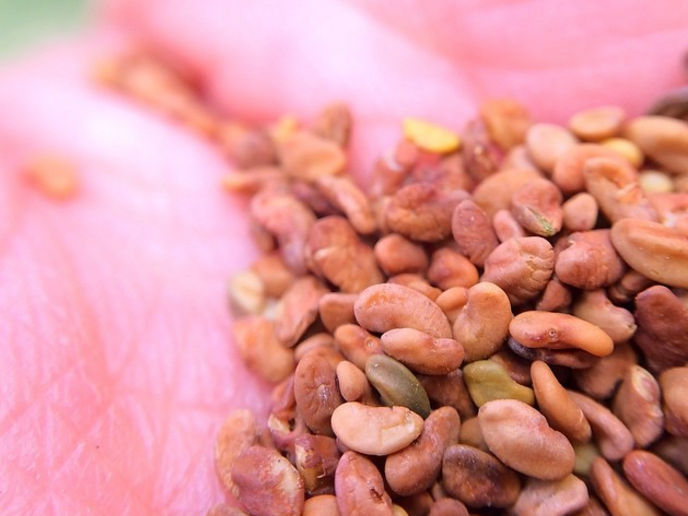Uncovering the mysteries of alfalfa seed dormancy through multispectral imaging analysis
Alfalfa (Medicago sativa), commonly called the “King of Grass,” is a legume grown in many parts of the world as a source of animal fodder. It is prized in the forage industry for its high protein content and biomass yield. Recently, alfalfa protein has found applications in aquaculture, pet food industry and human diet. Furthermore, it is seen as an environmentally beneficial crop, with positive impacts on biodiversity and soil nitrogen conservation.

Scientists in China have now used multispectral imaging, machine learning, and “omics” to reveal the mechanisms behind alfalfa seed dormancy
m7sanchez
Alfalfa produces two seed types—hard and non-hard—with no obvious visible differences. Unfortunately, the hard seeds cannot be avoided and pose a significant challenge from an economic standpoint. Hard seeds have low value as they exacerbate slow germination, nonuniform seedling establishment, increased weed competition, and germination failure. Seed dormancy—the delayed germination following embryogenesis—has multiple dormancy categories. Of these, hormone-mediated physiological dormancy (PD), hard seededness for physical dormancy (PD), and combinatorial dormancy (PY+PD) are suspected to have a role in alfalfa seed germination.
Notably, there is a dearth of hard seed research in legumes and until recently, dormancy in alfalfa was thought to only include the PY type. Now, scientists from the College of Grassland Science and Technology, China Agricultural University led by Associate Professor Shangang Jia have found the PY+PD pattern in this species of legume through multispectral imaging (MSI) technology combined with ‘multi-omics’ platforms.
Their study was made available online on 31 March 2023 and was published in The Crop Journal.
Explaining their motivation behind pursuing this research, Dr. Jia says, "Studying dormancy in hard and non-hard alfalfa seeds is problematic. Doing comparative research by soaking the seeds in water–a technique called imbibition–is time-consuming and causes the non-hard seeds to germinate. We needed an accurate, non-destructive, and high-throughput approach to gain deeper insights."
By combining MSI with multi-omics (transcriptomics, metabolomics, and methylomics) platforms, the team developed a high-throughput technique for identifying seeds, comparing the dormancy pattern, and observing differences in physiology, metabolism, and gene expression in hard and non-hard seeds.
“The technique could successfully identify hard alfalfa seeds with high accuracy—of up to 100%. Furthermore, the transcriptomics, metabolomics, and methylomics analyses revealed that abscisic acid (ABA) responses played a key role in hard alfalfa seeds,” adds Jia.
ABA—a hormone that induces dormancy—acts like a sleeping pill that keeps seeds in a dormant state. Moreover, the balance of ABA and other hormones like indole acetic acid (IAA) and jasmonic acid (JA) also govern the degree of seed dormancy. Compared to non-hard seeds, hard seeds were enriched in antioxidants and flavonoids, lipids, and hormone biosynthetic pathways. Furthermore, the increased expression of ABA genes and the differential methylation of ABA-responsive genes in hard alfalfa seeds underscored the ABA responses.
The team also identified non-PY hard seeds that contained higher ABA/IAA and ABA/JA levels and did not germinate following treatment to break dormancy. This finding gave credence to the involvement of the PD pattern and indicated that PY+PD, rather than PY alone governed the germination failure of hard alfalfa seeds.
"We believe we've provided a theoretical and technical framework for exploring alfalfa hard seed dormancy, and our findings could certainly guide the optimal processing of these seeds in the alfalfa seed industry!" concludes Jia with an air of excitement.
The scientists are confident their findings will have a strong bearing on future research and could have immense economic implications.
Original publication
Other news from the department science

Get the food & beverage industry in your inbox
By submitting this form you agree that LUMITOS AG will send you the newsletter(s) selected above by email. Your data will not be passed on to third parties. Your data will be stored and processed in accordance with our data protection regulations. LUMITOS may contact you by email for the purpose of advertising or market and opinion surveys. You can revoke your consent at any time without giving reasons to LUMITOS AG, Ernst-Augustin-Str. 2, 12489 Berlin, Germany or by e-mail at revoke@lumitos.com with effect for the future. In addition, each email contains a link to unsubscribe from the corresponding newsletter.
Most read news
More news from our other portals
Last viewed contents

Study innovates in gluten-free formulations, creating more palatable and nutritious bread

Transforming food systems could create multi-trillion dollars of economic benefits every year - Transforming food systems around the world would lead to socio-economic benefits summing up to 5 to 10 trillion USD a year



























































